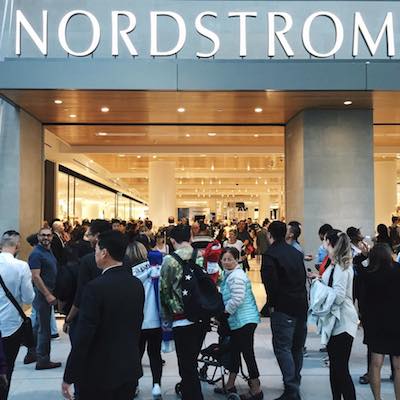Hoping to combat problems caused by digital retail giant Amazon, department stores are now looking to paid search to increase visibility, according to L2.
According to a new report from L2, department stores see positive results from organic search visibility but are lagging behind major beauty leaders and cosmetic brands. Cosmetic brands are leaning more towards specialty retailers instead of department stores, which is why the search visibility is a problem.
“Department stores are investing aggressively in paid search strategies to remain visible as the sector faces increased pressure from Amazon and fast growing pure plays,” said Griffin Carlborg, research associate at L2.
Department store insight
Amazon, Wayfair and Overstock.com are still dominating the home and garden industry with department stores failing to invest properly.

Since 1999, department stores have lost roughly $75 billion due to the disruption of Amazon. Trendier brands are also leading organic search ahead of well-known department stores.
For instance, JCPenney previously held the spot as the top apparel searches in US search terms. However, Asos has now surpassed the department store, with not much of the brand’s sales coming from JCPenney.
In-store pickup is also continuing to push forward with 78 percent of consumers expecting to adopt the technology by 2020. Asia and Europe are seeing adoption rates of almost 80 percent, as these regions focused on in-store pickup early on.

In 2016, only 25 percent of U.S. shoppers used in-store pickup, but half of them were first-time users, which means its popularity is rising.
Department stores can use in-store pickup to offset their ongoing problems.
Additional insight
Department stores are in a tough spot, continuing to struggle with attracting new customers in a world that is heavily slanted toward ecommerce.
This is particularly true for high-end department stores that are facing issues with underperformance in implementing in-store digital tools and competition from online and direct-to-consumer sales from brands. This data comes from L2’s Department Stores 2017 Report, which also ranked Macy's the number one department store in terms of innovation, edging out last year's number one Nordstrom (see more).
Research is showing that Gen Z and millennials are uninterested in shopping at luxury department stores, a trend that will become increasingly problematic for high-end retailers as the demographic ages.
Crowdsourcing savings platform Dealspotr released a survey on generations and their shopping habits, which showed luxury department stores becoming increasingly unpopular amongst all age groups. However, Nordstrom remains a strong retailer with Generation X- and baby boomer-aged consumers (see more).
“To achieve top visibility on shoe terms (e.g. “heels”) Macy’s, Nordstrom, and Zappos allocate spend towards more than half of the terms for which they appear organically,” Mr. Carlborg said.
{"ct":"JIyRG3uFBgrANiGQTDTgt6urf40HnrQ1ayJ\/hH+0axRfEyEqs4bG0qDh+VSdpu1QJLXY0yYkqhja\/ThlI5rBy4g\/Q4IJUm2NnQDLY1ChWYowO\/CNcNeRS8JpSVAa8amWl6SEcbXkST7d72CsQXqUQzZ48VdwflqM\/ykaKF7F8EPt4JTSgD2X2CXJJnd7aXgfBGh6+IQKJcUAolqDkYM75qpEFTnVGT56xnWUyFK0aZaxQQGT1lxNloGv3moiguM2aUVSh0ECw8EgJsmgsGaeOcrM9oIEnoovOTN6f6Sl2gP4ofRijn4MUg\/MH\/3jEj78mMrwCdvjlFGyCjbc6Hqjz9IhaQPHoDn1A3UFsJyUgT4fbkiuINzkkmwG\/J5h7Gvz6cTF1B2DwprALM3hEp5RqUxm6Pqgtiaf+DcBaLvirhiJZ5+DHua6D\/o0iys1RnESh6ExzJlZ2OLp3tN\/NU\/JLxt\/4R6yxY12v9bqL1wpIHrDhhMakCN6E\/MvgTWiQpozlIe3PPt66ifX7N7ag5XK7uhMsZv89ePDUXyW+slIde11VDOCZIwxbVRCPV3hw07axeXkZbaGZUDuiM0stKjvFE\/yN4fJeoRi8r6BRXw0ojDQ3SES02Amoqd1hMLFdjklSS2m7hZsgyMaaWQDlGa\/kbG2ftoBBzm+xat+RIxSvWfoWZfaLaHazrAaY8qfysd2QX3xKeKyJnyfWvZnk3JQGGRxl8FKNFkP9pgYTqkTYbupCgnHbv5FP5Qs2r+ESfp+9qBSxJnAItNTbtE+Frqcj65zedBcCmCbZnTjftTtxQa\/+SmQFh\/5szkVOh1E802qqLrAynSLTWmecCDFbxnKJp4rFXRLtIcvVoCCTqJtS7LZYGNzEI2a0lyApy0C6RAID0gnuEDDBEYUFrpR7OnaRHI3jLKDQJWLvPx28s9CH5wdmCu85jG3YmZ7oAnERaQXSiXgbqwCeMWpT3u8LQajB5EOm7sYXXWrSEJ8diVia2Q6yDPD6IZxsoqPoyXpfjDQ39Z99+5isVO8w5XP5vcWbL3oJShE+evUiBqA7uiW46dve3MLVC1k6boiTxhfTaGa4Vi9G4SdDr2joQjxxjw955bsJzvYuesmbHfm+RoXPLwjy08t57DPi36VvqGaJm8QUh1iw\/7TrCPFfTXF6eb+PbF9WXBPxeFjLjLmS1FlUrg6oXrW3hFQvpv9UHklwgSndQDnG1MCqmVAHmODtNcNqX3L6alLNT2YA799ttnScJOHw8XFj6S+Y1N82KqRZzM6GOxHgdchJ+ZgYBiUIcvxMd\/Qbxel1rhzwUthGJ1q+iLiDr429SUvC6b90HXQidHRnghcwk8LtxgCvO\/uwGCKvVg\/hku4TJxPvjnlLAnyr3XeJUwASzh\/EgoHVgXb8wFrIuHpCzTkvwc6+vTN2+66k1RrhSroQd\/nIezwMd3ms9IMesP+mS1R+oYXyekfuqJzt+7ihV2kwVfMWVWKeOSFykMI2vyUD2npkiGzfJLhYVA65kJ7PZuFJxgo+VO4BblBh56KpoT6f3IVHooTTDRjKPKURpOv\/LzqkHxr7SgqPa+VzaYVT8pYwMNNkzD9o6PeZZsGeESNfBmtw\/VAhJDjX5jlw28eWDuBLT5axPAG4+uiei9s6586NVLijR\/ISIKtGfXNzc5vXHEC58QfTt+PSXofAuC7VMJfARtBRx0FBJYxeC4LkwgUEHHkeCpFdeEp+FVGSxFU4xZygqBVPt5YkQgnARFpMT9CbuW5AGMXzrBtyIs1mC\/ThK+wx+I8W6JdH4JRHD\/07kvOcoTDoTfORhqqW\/Bmx4FJ7w1v6Uhya8+xtEzJ3kFe\/jX1bb7kKsifNMoA8eo1lBme2KCdcsJ6q9GJ0oV+sv0QRL1fs1KsRTDUJObqE6AcJgy7Xz6BjW3FSKsu5OjKVUlfd5KzK8AvtAJHoBrOfHa\/oDS7m8XgG\/EXMJaUHoZJl7IZsonTUskkFlOd7ib3ZPOHASVp28Dy843VfIOBQD4TjaAyfbFGOZWZnVfWG0DC\/PcoJOGK9I9TvqdDT0AF\/4mVbdpvHOg1kSMdB5gBZsbjf\/LzZHXZWPs+ADBn4ldaiN9EiKcWcNkmUeoYJ6q9RCBZ5xQVqSejlOYaYjissMU5GoZqzwqfD3vYrzlJtGZ+fHLiUQt79C9BgqujwBIi2BtAOvoZEYco0+gEdtrdv1YXugBlHBynSrLp7F3vizMx1gU9UodetCdjzHNl\/AHuUFQvu6TGPVVgOAEC7rPoDBhZfBnuVc087VJhCxMQ4Rq4ub8O1jNyNekRRW4CV2dU0kxa6jqbrGoBrQZ9YAufbJE6hTozHSKFInnyjkFvgoO+ag0HJMjBzPFMOd+t3XBishzbHuwgMTdN1BD0Ij8Je0D9\/eNFkB1ZlwRxUv55ycMMcyzxzDtm3kCgmSRre8zZOSQBeJPa5JLV5A8g6EB9XQnRE3RNT8JgLHT080ZVw4Q3ki892gKdg+Y1+wT7vRV31Vn+rLBIgDQBAOcdjI4QZQMBL5+kDO88JhW6U+P3rudq2un+u\/V3hRxYQQtBA\/zlxFnDJPK2F4YrM7iAw76iBHJmLcZ5csT1VEU5gR2Fs5O9VMg10zVN64G8LAiPX7G9daY3wIHuV9ZEsX04OLJjcoAUFE6Hlx6VZbPkWoL4J8mdNakBr0kU1n9RCzR7XNQVV8SsoAUHUeXbheCXAUb+9U8rPxF2Dels\/hi0ehOXKdIuoA\/UrUJZK1Li+obE+gcT5HIO3fs0MQW9XOhWk48gCpxqVxzMjnK9FAjFIZTk3\/t1zlLFl47\/RBweQY1cFRMxrSbdzIwUvy00Cxeqp+vzAVpcy+qVIMtUkjgS8VOgEiXHh7xyiWdoXtCaYLRHQYb3hG9DzCZOHLXsZA1Cf7kp6QzGB+jUPZK0Fl+FpWypczWBcClR17Jq37jxnIGinTUjW7ER8RntTlnu4fPJ6ylWYK4canVddtin9BHSRfvOCZd0aFmytvcfBMwaAQ632MIQd+NcUUMthJg\/l+1q0We0x3SfZT90+jbRZp88g00L972lDA1456kX\/ZXBuTVE1MQlbcuEtvmEQ7zfOBb4RWV91waQFJ3fYj1gVpCeNDqmqTFkrNVZL4oPpUMYw87iBJr\/sIHdN75Y8eUMl+FgPqIuL85yj37wrPwtsAgJ92vHqrf9uC0+OmdYHj1G0Yw382gmfdJwAKA6vsJCB7S71kZrqB1pILXh\/qOuNU6R4dzKl6Pzf7YleHZzaLXi3O9bDunye3qVzJB9s4E5Jb\/juY+ptF2M6MsaKDbbzJ\/YfVILLv9iKhb1zeDf4ZY6R6Wz2PitKgCbUZghuvu1Wz2lmyqsCBapO7b3Z2F8PwlKCwwX\/KFwFFGCikhw8\/pP9bVT2dCVs2tTf18aIlEFVfOnzZd4kNrgBY+yaVCUru2bf5CaE\/\/ILnjgVzrB++Kg\/BhVhHh8cIUoLjIQvFSibE5xiNtZttoBUP6MjEwqPYPmTpW53oc4sXrJyB2kedpaDuoaSbb6n9bO+1exT5lrYA93t7r4frcjHnAsd6fJweQd36AHmLimlRR3l0jHDo+0v0xOiw0Fk9KIpBOtN1n4LHDr0LNSeapSZ14Am1PYGopUkrisaalbt9b18sxJ6K\/8qU\/szZ6fTBhn8XMKkc+RH1r+trKlwSHJDYbjNVMMecWDPRG9adBqKqCAAfbo7FV6fOtTFpmQm44CglUOnGR7TRGB1f51vOU7B5OYTQDZkNJKO2lyCX\/w8nYuRz75PHP6GSwCumbtkAfLCKp4yyGHkwjdRKp\/vjd2Fhr1W4Xw3gH4D1TdiJppea25bf5FOqeaNIeM\/9fAqznJZ0zhF\/+FyZUodju4CREKyXTK69FBOeGHwKKLu0rqChh+1LVkYNRYTmxj9bKjMhi+h5bAJe7MUq8v+o50\/Kg7\/D8l46jmCHV+IQ0z3o+VcJHFCaQYiUae8fkI6umPk8IXHEsidde2Ew8q9tfd6g40+vtKjoxUZjkes\/bFmGYymquotlWMhm5FVBF8IB\/1cCxnlBODHyR+xu\/dX60hHoKJABtOdX8yC7OmtLoMNz\/TpT+DEdoZLxzZt57x5tw\/wpGGxWjtaEhR3zxQZLRn\/h\/YXC95k8ikVNE6n8Ji8Gut+UseQ05xwHEHTorw9TVl0ybGdY2zNCLhvNJxhBL5HpTpoR6vzWVeJndT6x+Z3iv19f\/jIYevGBEAn0nm81jSj5WXxuMFOlvD9833Fw9uIcV71I+mL6hFJW8xmWFwiI\/RJg8fl57Qam+qj2rivXFzyq01mNiqiCT\/2OnynfNpNNJiLQkmh3l7EoEcdXHuAVTNskidc6eQrGOCYaBzo7+81E3PGrc4U5E1D2IOyn9gzHK33AXDM\/DKPYlYdRlKUg+K2m+lvT\/3TrGvmZqLaUUCoXZ3+ghw7qJ8pOy6hjsObiyZwq34zgaSwW3QHAkvQ9rv8S4OQOj7qOS8FzKshiBAk6NkZL6vg\/tP+Dut4By5cc9gO3A5b5PL1m1eiLwFwi2\/xHuoH87dnoNrU9BzoGkvc5d5quuOohXwlh2HVTl\/dvr30SPS+FSTqv0ZOfoxxI0XDn\/2X\/UpFa+l3zOGhyMESf0MHzk24J12dX+g7XwOEZGzjvQWjmIVJtYbxkaXCXJoLJp2Nrh9ZAbHPChZjre8BJ5+CvM4qc1JWEi7nY7jLgTQecjPA1tLmiN7gVx1gd+KfCYVmnq4pCJ7C7AwCeT3kbRbv85l6eLNkGyQVEkegMRfvKAIKuDswUCn83L357XmOfmjU6sivDRSfkww8GtTy1HFPLsSVOeGb32tVcefC8ydcnHCUd6oXtH1Ntj+KAtBQoBGJ+hhfQJZ+d2rBEU7DCkH4zy3NUKZJ1+BMy4+jd8k4FA53E1BpjdMFKlN1txH8wVztKMWl5MUlUGebpbbNkJvpHt\/oZ9DIEeghuhkIP0MZ9UddSIBG+5zgaFL2YQc3qSnrsD8+\/bzSjfSFXwKoO5\/ZJ2iao+yX5Scv3yQmGg37HyXU4ZEH0waldROitQy4IelA3k8OvlLcoFMmjBlsXsn62Hr\/8iehVlunxRe1p03r6JVe3uJYEgnt1IOOEHXrWjZd65dtdqWYWjaDHiLuGhVqXvn9KgP9C7UC0OQ2bFo6q48fQIOAgRQxfd2NJP0Hx6b9C1vfypQxGtpA1u9PxCvwHoe0UGeiMK9G3AxFKB3hXnpJp45ljmXHEW2M3x4UMS7BVYvIFFPXWocJq8xeKH5NmlEYiqZWu2uuyFJh37mES6tBfBisyYfq93NnS4QMHBW2mci4TvMEKcjO7GsH2VKXZSbYTcWYdpt2XiGEcZ95dGyb7gtHyUgBZD7ukS4y3gvq4aIiCM9If8L7W8wsp\/NhuAhxC2nXWYk9XnE4LSK2fbQS3CAILsap+zEsSXfkARKq4uX1kI6HhE9wtL87l3vrc8+ixBGr6ycqCXJ1h2N5JNlraFELQjtHfok1c+mRtkKtM3gpfsEi0Yp1enSl8ffp1O1j6SUgtytKd5UHMJK30VrPGz7gQw=","iv":"8dd416562507f61c85c46ec837c1f4a4","s":"ba68b26f7f3d03de"}

 Department stores need to work harder to combat the Amazon problem. Image credit: Bloomingdale's
Department stores need to work harder to combat the Amazon problem. Image credit: Bloomingdale's